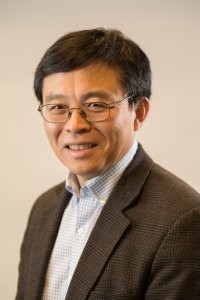Columbia Chemist Xiaoyang Zhu Wins APS Earle K. Plyler Prize
Zhu is recognized by the American Physical Society for his research on the spectroscopy and dynamics of molecular condensed materials, which he is taking to its quantum frontiers.

Xiaoyang Zhu, the Howard Family Professor of Nanoscience in the Department of Chemistry at Columbia, has been awarded the 2023 Earle K. Plyler Prize from the American Physical Society (APS). The society recognizes Zhu “for seminal research in the spectroscopy and dynamics of molecular condensed materials.” Zhu will receive a $10,000 award and be recognized at the upcoming APS national meeting in Las Vegas in March 2023.
At Columbia, Zhu is an expert in spectroscopy—that is, using light to understand matter. “Think of knocking on a piece of firewood: the sound can tell you whether the wood is dry or wet,” he explained. “We do something similar, but using a laser to ‘knock’ on a material and then ‘listen’ to its vibration.” The vibration frequency can reveal hidden secrets, like whether particular interactions make it behave in a given way. Zhu has focused in particular on semiconductor materials over his career. In some of their latest work, he and his group are studying the collective oscillations of atoms, spins, and electrons.
The Plyler Prize for Molecular Spectroscopy and Dynamics was first given in 1977 to another scientist with a Columbia connection: Charles Townes, the inventor of the device that sparked the entire field. While at Columbia, Townes developed technology to coherently control microwaves. That technology, which was known as the MASER, gave rise to the lasers that scientists like Zhu use to this day to probe the properties of different molecules and materials—including at the frontiers of quantum materials, where Zhu is pushing his research.
The year the prize was first awarded, Zhu was just getting ready to enter middle school in China. A few years later, he enrolled at Fudan University with the intention of studying mathematics but was instead routed into the chemistry department. His original interest in math and physics never abated, and he would come to look at chemistry through a physical lens.
“Xiaoyang’s work borders physics, chemistry, and materials science, with a distinct signature of combining a physicist’s rigor with a chemist’s intuition to tackle the complex problem of dynamics in condensed matter,” noted Louis Brus, Samuel Latham Mitchill Professor Emeritus at Columbia, in his nomination letter for Zhu. “His discoveries speak of Xiaoyang’s keen understanding of condensed matter dynamics and his uncompromising virtuosity in the application and development of spectroscopic techniques.”
“Think of knocking on a piece of firewood: the sound can tell you whether the wood is dry or wet. We do something similar, but using a laser to ‘knock’ on a material and then ‘listen’ to its vibration.”
Since Zhu’s time as a PhD student at the University of Texas, light has been key to understanding condensed matter, a branch of physics concerned with properties of matter, rather than single, simpler atoms or molecules. Matter includes the four familiar phases—solids, liquids, gases, and plasma—as well as quantum phases, such as Bose-Einstein condensates, magnetic spin phases, and superconducting phases. “I don’t shy away from complexity,” Zhu said.
Early in his independent career, Zhu and his research groups made notable discoveries about so-called charge transfer excitons and their role in organic photovoltaic solar cells (OPVs), which transform energy from light into electricity. Zhu discovered that charge transfer excitons can be quantified, which has helped advance the scientific understanding of how to improve the efficiency of OPVs.
Since he joined Columbia in 2013, Zhu has turned his spectroscopy tools from conventional solids to the more mysterious quantum phases that turn up in the two-dimensional materials that his collaborators here, including engineer James Hone, chemist Xavier Roy, and physicists Cory Dean and Abhay Pasupathy, have become expert at making and manipulating.
In recent examples, Pasupathy’s and Dean’s groups, along with other global collaborators, showed that electrons in 2D materials such as graphene or tungsten diselenide can interact collectively to form an insulator, which blocks the flow of electricity, or a superconductor, in which currents flow without any resistance, simply depending on how the layers of it are stacked and twisted relative to each other. Zhu, a member of both Columbia’s Department of Energy-funded Energy Frontier Research Center and National Science Foundation-funded Materials Research and Science Engineering Center, wants to understand why. “I’m taking spectroscopy to quantum phases of matter,” he said. “We’re going to knock and listen to what comes out.”
